City Trip to Trier: Lose Yourself in an Abundance of Roman Heritage
Our first stop was the oldest city in Germany, Trier. Also known as Roma Secunda (the second Rome). A former center of the Roman Empire. Charming streets and imposing buildings invite visitors to embark on a journey of discovery, seeking out the hidden stories of the city. And of those stories... there are many!
The leaves are turning yellow and red, the air is growing colder, and the world is covered in a layer of nostalgia... it's autumn. The perfect time for a cultural city trip! That's why we boarded the train back in time. Towards the German state of Rhineland-Palatinate, directly on the borders of France, Luxembourg, and Belgium. Our destinations? Trier, Idar-Oberstein, and Koblenz. Three charming cities that are part of the so-called 'Romantic Cities'. Connected by history, but each with a unique character.
Trier boasts no less than nine UNESCO World Heritage sites to visit, eight of which are located in the city center. Quite a challenge, when time is limited. Fortunately, we didn't have to embark on our quest for imperial treasures alone, but in the company of our knowledgeable guide Heidi. With her thorough knowledge and humor, she guided us past churches, cathedrals, and former swimming pools.
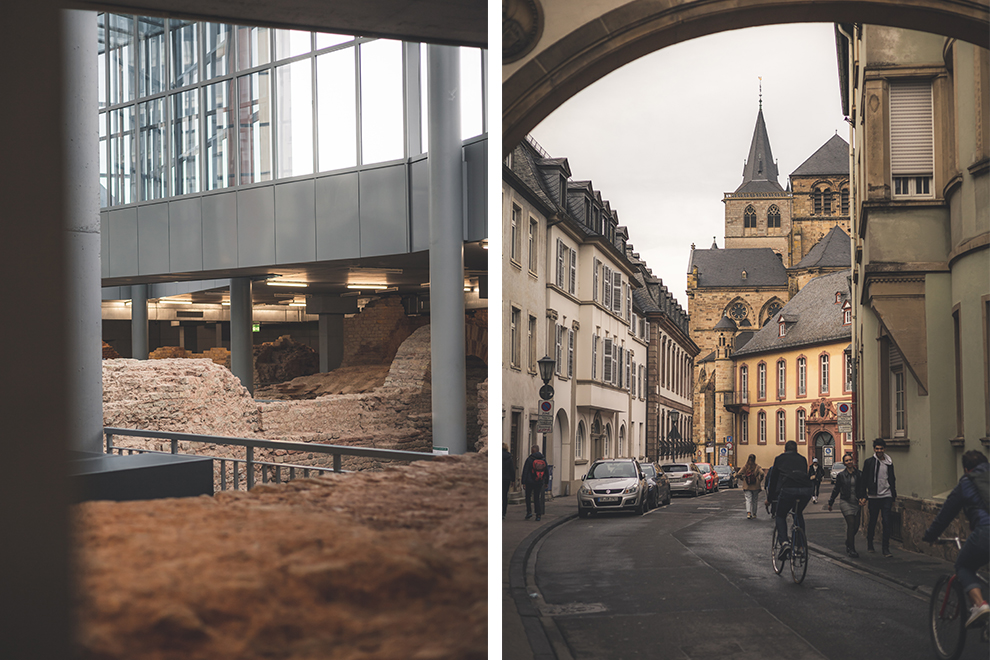 Left: Underground ruins of a former Roman bath, the Kaiserthermen. Right: A glimpse into one of the charming streets of Trier.
Left: Underground ruins of a former Roman bath, the Kaiserthermen. Right: A glimpse into one of the charming streets of Trier.
One of Trier's most famous eyecatchers and highlights of our tour is the Porta Nigra. The black massive gateway to the city, which was once part of the Roman city wall. There used to be four such gateways. White, and neatly symmetrical on each side of the inner city. But the Porta Nigra is the only gateway left from Roman times, and the gleaming white stone has turned black over time. As if the building itself has acquired the wrinkles of old age.
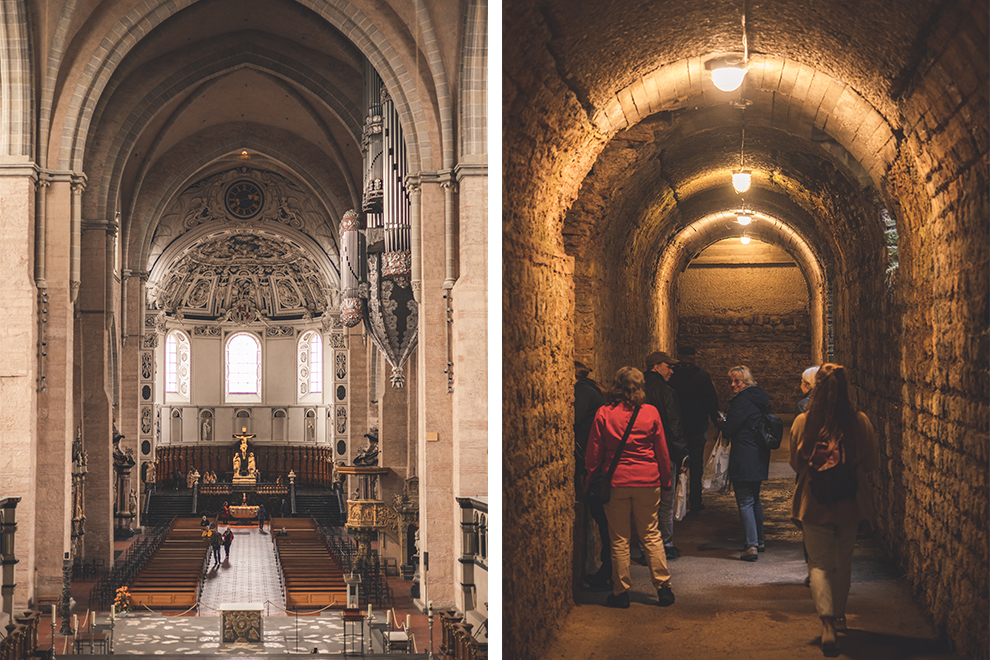 Left: Interior of the Trier Cathedral. Right: Walking through the sewer system of the Barbara Baths.
Left: Interior of the Trier Cathedral. Right: Walking through the sewer system of the Barbara Baths.
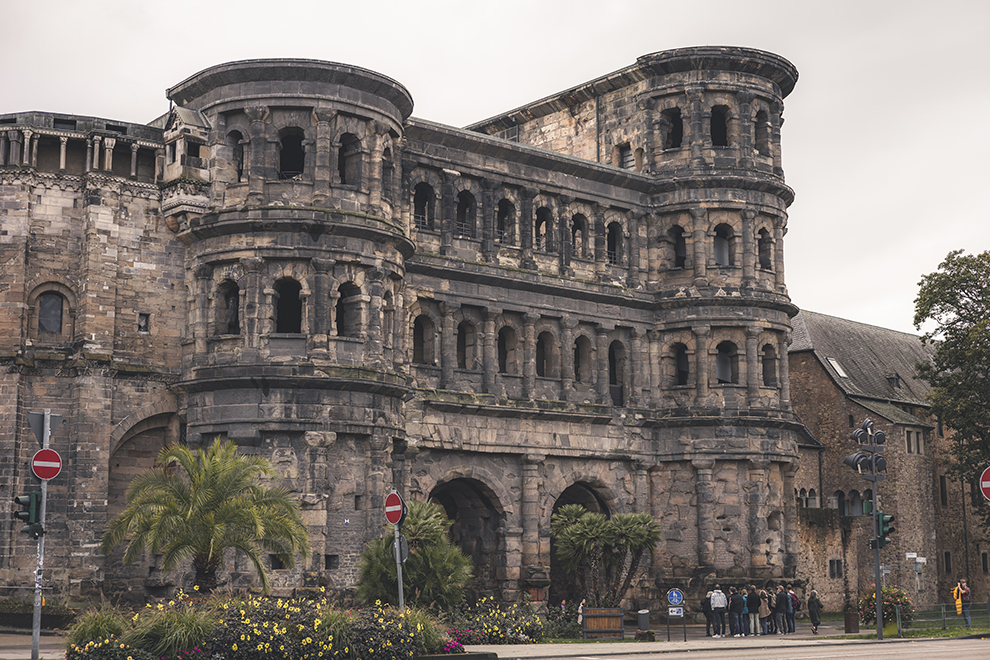 Photo: Frontal view of the Porta Nigra.
Photo: Frontal view of the Porta Nigra.
Buildings like the Porta Nigra have undergone various transformations in terms of their shape as well. Supported by a map full of colorful images, we gained a playful insight into how Roman buildings in Trier have been dismantled, rebuilt, and transformed over the centuries under the influence of Roman emperors, stone robbers, and holy hermits like Simeon. For nearly three hours, we marveled at the remaining imperial baths and cathedrals, both above ground and underground – in the sewer system of the baths.
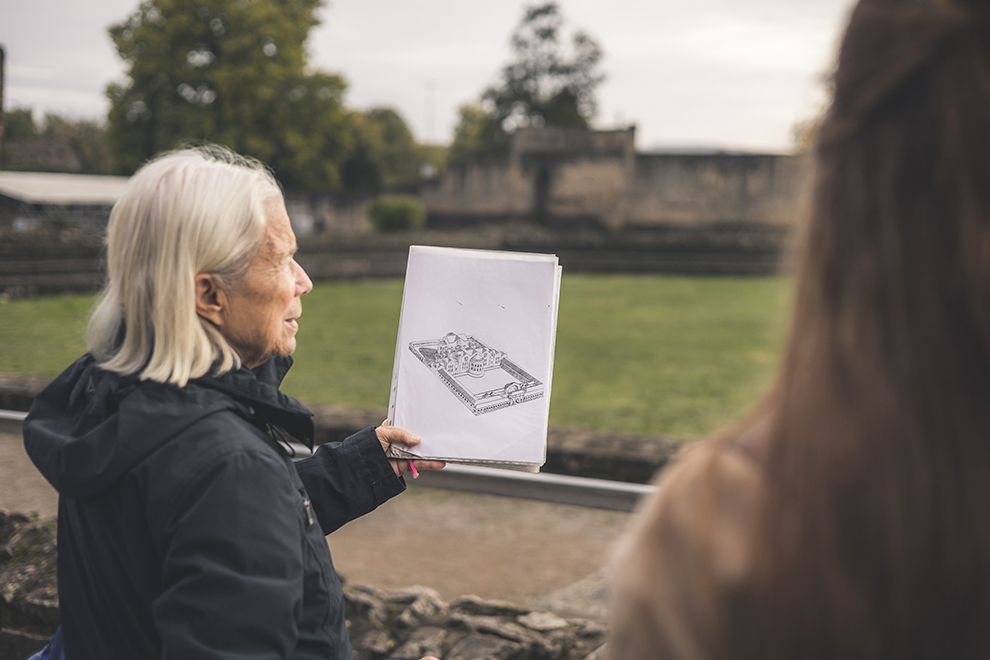 Photo: Heidi showing us a drawing of what the Barbara Baths once looked like.
Photo: Heidi showing us a drawing of what the Barbara Baths once looked like.
Architecture and Famous Residents
The changes throughout the centuries are particularly well reflected in the architecture of the impressive Trier Cathedral and the adjacent Liebfrauenkirche. Despite the fact that these two buildings stand side by side, it is immediately noticeable (even to the layman) that they clearly differ in style. While one bears a Roman imperial stamp, the other adopts the more rounded slim forms of Gothic construction. The green courtyard found here gave us the surprising feeling of being in a Harry Potter film.
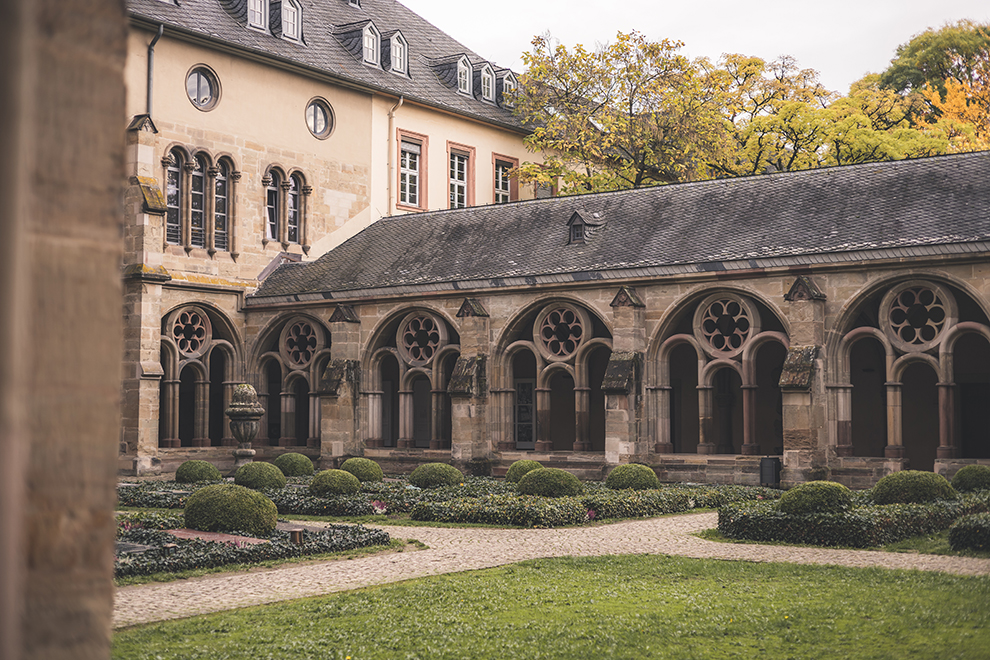 Photo: The inner courtyard of Trier Cathedral and the Liebfrauenkirche.
Photo: The inner courtyard of Trier Cathedral and the Liebfrauenkirche.
Autumn remains a changeable season, with a chance of rain. A good place to escape the rain is the "Rheinisches Landesmuseum Trier." Here, with the help of our Antikencard Premium, we visited the temporary exhibition 'The Decline of the Roman Empire.'
For people who don't necessarily enjoy museum visits, there are plenty of nice spots to shelter in the squares and streets. For example, at Casa del Café, where we quickly stepped inside. It was time for a cup of good Italian coffee, chosen from a kitschy bright pink menu, with a somewhat misplaced 'Sunshine Reggae' in the background.
From here, we had a view of the square - the Hauptmarkt - which is one of the most beautiful city squares in Germany. Of course, the square is surrounded by photogenic buildings and flying groups of pigeons, but the Hauptmarkt is also adorned by an old fountain. The Petrusbrunnen, with a statue of Peter on top, the city's patron saint. Traditionally, Peter receives a bouquet of flowers from the mayor every year in June, who then has to climb the fountain with a ladder. "Sporty or not!", joked our guide.
Karl Marx and the Porta Nigra
Another celebrity from the city of Trier is Karl Marx. Not only as a giant statue donated to the city by China, but his image can also be found on some of the traffic lights. As the green light figure, he proudly carries his important book Capital under his arm. "But do you see that building where the Euroshop is now?" asked Heidi with a smile. "That's the house where Karl lived for a long time! Funny, isn't it?".
Of course, to conclide, a view of the city we just walked through is unmissable. That's why at the end of the day we climbed the stairs to the place where the tour with Heidi began: the Porta Nigra. This way, we could see this mighty gate from the inside while being rewarded with a view of the city from above.
 Photo: Enjoying the photo-worthy view from the Porta Nigra.
Photo: Enjoying the photo-worthy view from the Porta Nigra.
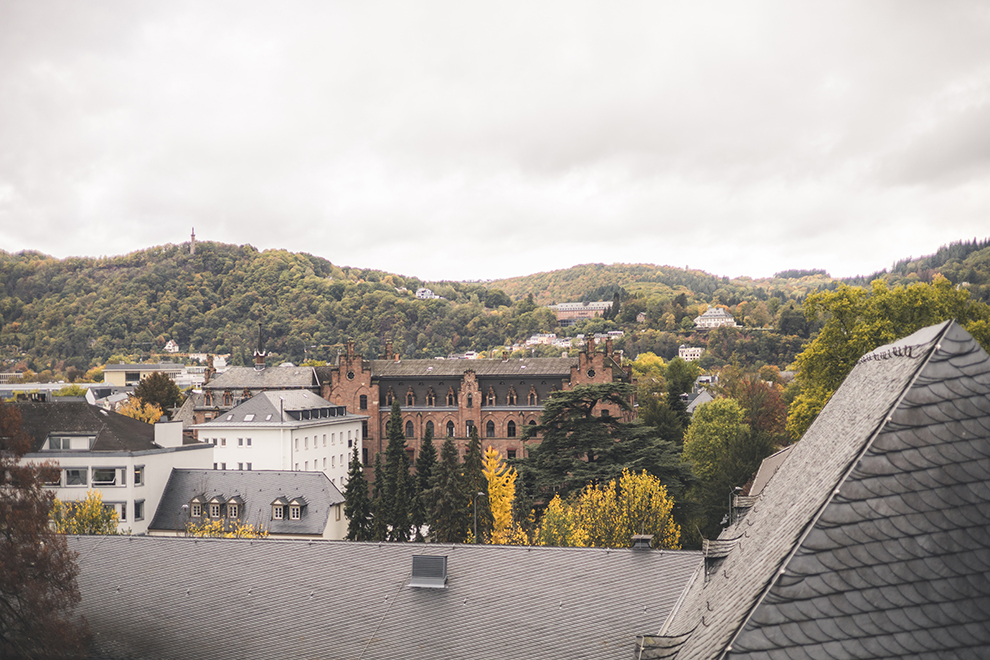 Photo: View from the Porta Nigra.
Photo: View from the Porta Nigra.
Regional Wines
In Trier and the surrounding region, autumn doesn't just mean rain, but also something else: time for the first wine of the season! This federweisser wine is a kind of cider in wine form, and can only be found in this region. Sweet, cloudy, and with the added flavor of apple juice. But for adults, of course. It was an opportunity we couldn't miss, leading us to the Weinstube Kesselstatt for a delicious lunch. A popular meeting place for both tourists and residents of Trier, with a rich assortment of regional wines and, as a bonus, an almost fairy-tale-like view of the Trier Cathedral and the Liebfrauenkirche.
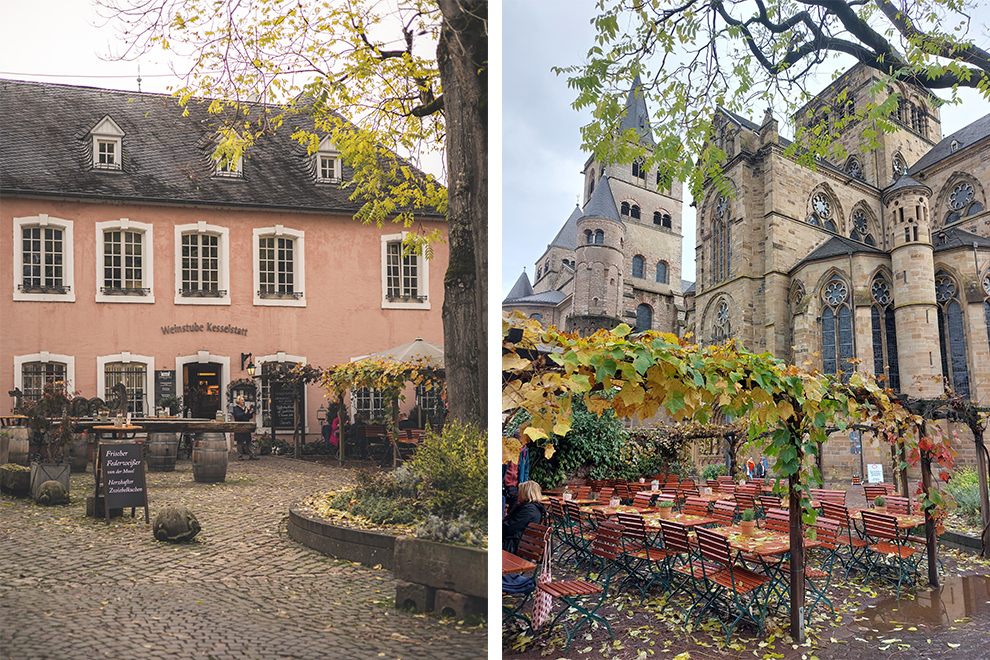 Left: Front of the wine tavern. Right: The terrace of the wine tavern with a view of Trier Cathedral and the Liebfrauenkirche.
Left: Front of the wine tavern. Right: The terrace of the wine tavern with a view of Trier Cathedral and the Liebfrauenkirche.
After enjoying one last glass of federweisser wine and picking up our belongings from our accommodation Hotel Pieper, it was time to catch the bus to the second part of our journey: Idar-Oberstein.
It's become clear that these cities each have their own character, despite being connected by history. The Roman history and heritage of Trier, the gemstones and Spiessbraten of Idar-Oberstein, and the wines and the fortress of Koblenz leave a taste for more. Fortunately, there are still six more Romantic Cities like these to discover in the future.
This article was written in collaboration with Rhineland-Palatinate Tourism. Idar-Oberstein, Koblenz, Mainz, Speyer, Trier, and Worms are part of the 'Romantic Cities'. Do you want to visit one of the six 'Romantic Cities'? Then visit the website and get inspired >
Create your own blog
Easily add stories to your diary in our online editor or app
Add your images and choose your pages layouts
Share your journey in real time without the fuss!